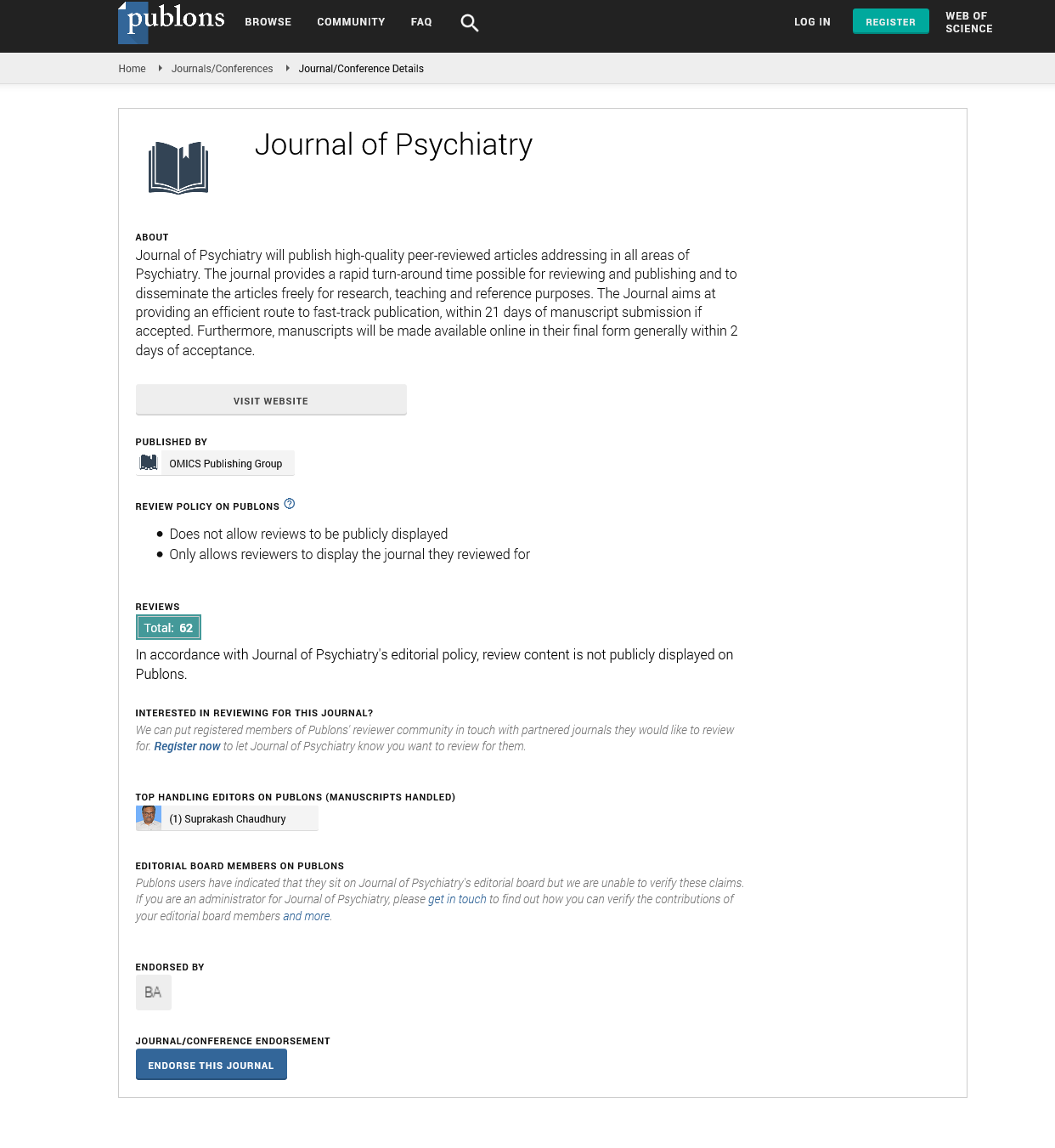Indexed In
- RefSeek
- Hamdard University
- EBSCO A-Z
- OCLC- WorldCat
- SWB online catalog
- Publons
- International committee of medical journals editors (ICMJE)
- Geneva Foundation for Medical Education and Research
Useful Links
Share This Page
Open Access Journals
- Agri and Aquaculture
- Biochemistry
- Bioinformatics & Systems Biology
- Business & Management
- Chemistry
- Clinical Sciences
- Engineering
- Food & Nutrition
- General Science
- Genetics & Molecular Biology
- Immunology & Microbiology
- Medical Sciences
- Neuroscience & Psychology
- Nursing & Health Care
- Pharmaceutical Sciences
Commentary - (2025) Volume 28, Issue 4
Substance Use and Suicidal Ideation Among Urban Youth: A Call for Integrated Risk Assessment
Walker James*Received: 01-Jul-2025, Manuscript No. JOP-25-30175; Editor assigned: 03-Jul-2025, Pre QC No. JOP-25-30175; Reviewed: 17-Jul-2025, QC No. JOP-25-30175; Revised: 23-Jul-2025, Manuscript No. JOP-25-30175; Published: 31-Jul-2025, DOI: 10.35248/2378-5756.25.28.756
Description
Suicidal ideation among young people is a growing public health issue, particularly within densely populated urban areas where mental health challenges often intersect with complex social and environmental stressors. In recent years, increasing attention has been paid to the role that substance use may play in elevating suicide risk among adolescents and young adults. While previous studies have linked drug and alcohol use to adverse mental health outcomes, the specific relationship between various substances and suicidal thoughts remains an area in need of closer examination. This study set out to explore how patterns of substance use among young Australians living in metropolitan settings relate to experiences of suicidal ideation, with a particular focus on cannabis, stimulants and alcohol. The research analyzed responses from a nationally representative survey involving 1,000 participants aged 16 to 24 residing in urban regions across Australia. Participants completed self-report measures detailing their use of substances including alcohol, cannabis and stimulants as well as indicating whether they had experienced suicidal thoughts within the past twelve months. In order to account for confounding variables, depressive symptoms were also measured and statistically controlled for during analysis. This allowed the research team to examine whether substance use independently predicted suicidal ideation, above and beyond existing mood-related difficulties.
The findings revealed a concerning association between specific forms of substance use and elevated suicide risk. Notably, individuals who reported using cannabis three or more times per week were significantly more likely to also report suicidal thoughts within the past year compared to non-users. Similarly, stimulant use, defined in this study as using substances such as amphetamines or ecstasy at least once a month, was also linked to a higher likelihood of suicidal ideation. These associations remained significant even after adjusting for the presence of depressive symptoms, suggesting a potentially direct or amplifying role of these substances in contributing to suicidal thoughts. In contrast, alcohol consumption did not show a statistically significant relationship with suicidal ideation in the adjusted models. While some individuals who reported frequent drinking did also report suicidal thoughts, the association weakened considerably after controlling for mood symptoms, indicating that alcohol use alone may not be a strong independent predictor of suicidal ideation in this population. This highlights a need to move beyond general assumptions that all substance use equally contributes to mental health risk and instead consider the nuanced effects of different drugs.
These results carry significant implications for youth mental health services, particularly in urban contexts where access to substances and mental health challenges often co-occur. One key takeaway is the potential utility of targeted screening practices. Mental health professionals working with adolescents and young adults should consider incorporating regular assessments for cannabis and stimulant use when evaluating suicide risk, even in cases where depressive symptoms may not be severe. By identifying young individuals who engage in frequent use of these substances, clinicians may be better positioned to intervene early and prevent the progression of suicidal thoughts into more severe outcomes. Furthermore, the findings point to a broader need for integrated approaches in suicide prevention. Rather than treating substance use and mental health concerns in isolation, effective interventions may need to simultaneously address both behavioral and emotional factors. This could involve the development of specialized programs that combine elements of substance use counselling with cognitive-behavioral or dialectical-behavioral strategies aimed at reducing suicidal ideation. Collaborative models of care that bring together addiction specialists, psychologists and community support networks may offer a more comprehensive pathway to supporting at-risk youth.
The study’s cross-sectional design limits the ability to determine causality, meaning it remains unclear whether substance use contributes directly to suicidal ideation or whether individuals experiencing such thoughts are more likely to turn to cannabis or stimulants as a form of self-medication or escape. However, the strength and persistence of the associations observed here underscore the importance of further longitudinal research. Future studies should track young people over time to better understand the direction and nature of these relationships and to identify whether early interventions targeting substance use can reduce the incidence of suicidal thoughts. In conclusion, this research adds to the growing body of evidence indicating that substance use, particularly cannabis and stimulant use, is strongly associated with suicidal ideation among young people in urban environments. The findings highlight that the frequency and type of substance used can play a crucial role in mental health outcomes and underscore the importance of targeted screening and dual-focused interventions. As suicide rates among young people remain a critical concern in public health, a more integrated and substance-informed approach to suicide prevention is urgently needed. By recognizing the interplay between substance behaviors and psychological distress, mental health services can move toward more effective, responsive and holistic models of care for vulnerable youth populations.
Citation: James W (2025). Substance Use and Suicidal Ideation Among Urban Youth: A Call for Integrated Risk Assessment. 28:756.
Copyright: © 2025 James W. This is an open-access article distributed under the terms of the Creative Commons Attribution License, which permits unrestricted use, distribution and reproduction in any medium, provided the original author and source are credited.

